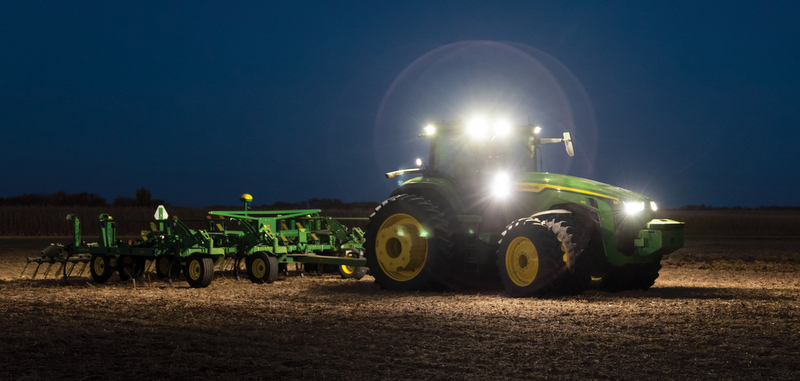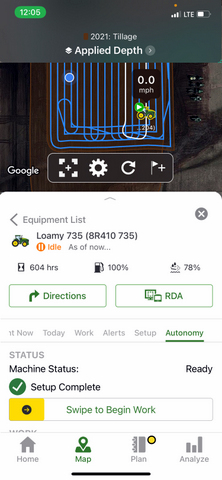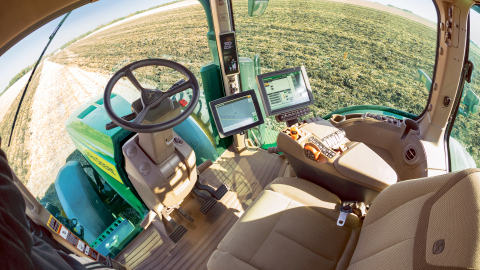Driverless Tractor Designed to Increase Productivity
Farming’s gone through several revolutions over the millennia. First, humans alone tilled the soil. Then they added animals and implements to increase productivity. Finally, machines appeared to move production to new levels. The latest will happen this year when John Deere puts its green-and-yellow fully autonomous tractor on sale.
The magnitude of change is on the scale of the switch from horse-drawn plows to motorized tractors, according to Deere. The pitch to farmers is clear. If you have an average farm, Deere says that could be 1,500 acres in the Midwest, you need some help with the narrow window around planting, applying nutrients and harvesting. Efficient machines can help, but they have required a pilot up to now.
A surprise participant at CES this year, John Deere used that tech super show to introduce the autonomous version of its mainstay 8R tractor. The rig is going to be pricey–potentially starting around $500,000–but offers a payback potential because not only does it solve the “missing farmworker” problem (farm help has been a declining resource for years), but it can be a 24-hour employee with a guarantee of precision work.

A Tech Powerhouse

The autonomous tractor packs a variety of technology typically found on high-end automobiles—six pairs of stereo cameras connected to a deep neural network capable of classifying each pixel in approximately 100 milliseconds and responding if there is an obstacle or task to be performed. The tractor will operate in the geofenced area as defined by the farmer, accurate to within less than an inch.
Clean Fleet Report was briefed on the tractor by John Deere’s director of emerging technologies Julian Sanchez, a Deere veteran. Getting to autonomy, Sanchez said, has been a 20-year journey. Up to this point there has been a driver in the cab, even though recent tractors were able to use GPS to accurately tend to farm acreage with minimal driver input. Sanchez said the autonomous tractor has been received with “healthy skepticism” from farmers, which has led Deere to consider a variety of potential approaches when it comes to the new farm business.

“We have innovated and reacted to what we’ve found with vehicles out in the field,” Sanchez added. The farmer’s field job now is to get the tractor to the field and configure it for operation on the system app. At that point the farmer can move on to other tasks while continuing to monitor the tractor while it performs its assigned tasks.
Due to the added expense of the autonomous tractor, Sanchez said Deere is considered alternative business models other than a straight sale or lease. He said potentially the autonomous features could be offered on a subscription basis. The days of the tractor as the Swiss army knife of farm tools appear ready to take a step into a whole new dimension.
The Big Picture
The ultimate goal, according to Deere, is to up the farmers’ game to meet worldwide demand for crops. As the population grows and cultivated land fails to increase in tandem, productivity from farms must increase. The autonomous operation of the new 8R builds on technology like AutoTrac turn automation that has allowed Deere tractors to essentially steer themselves in the field, along with See & Spray technology, a new robot that uses computer vision and machine learning to detect the difference between plants and weeds and target application of herbicide on the weeds. It’s plant-level technology designed to improve productivity while also reducing negative environmental impact. Similar technology is being used in the application of nutrients to boost the return while minimizing expenses.
These new, more sophisticated machines have begun data-gathering along with their other tasks, enabling more precise planting to take advantage of optimal soil conditions. This data feeds into the farmer’s eco-system in order to maximize productively, reduce expenses and increase profitability.

John Deere reports its connected equipment is currently at work on 300 million acres in 60+ countries around the world. The average American farmer is more than 55 years old and puts in 12-18 hours a day of work. That farmer is on a family farm in 96% of the 2.2 million farms in the U.S., which produce 78% of the food sold in the country.
An autonomous 8R tractor can prep more than 325 acres of land in 24 hours, according to Deere, an area equivalent to the land area of the National Mall in Washington, D.C. Deere estimates that using an autonomous 8R for tillage, a farmer will be at least two times more productive just because that farmer will be free to focus attention on another aspect of business while the 8R is at work in the field.
Advanced technology on a farm has got a real purpose. It looks like it’s coming along just when it’s needed.
More Autonomous Vehicle News:
Opinion: Why Software Is Key To Safe Autonomous Vehicles
Tech: Autonomous Vehicles Are Going to Require a New Brain

1 thought on “Tech: John Deere Bringing Tech Down on the Farm”